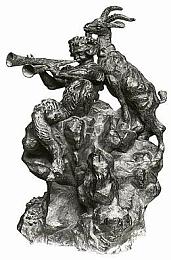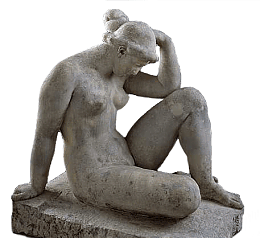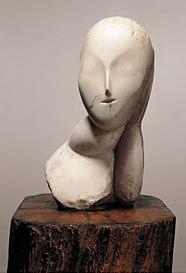H. de Roos - Rodinīs Approach to Art |
|
21. founding father of Modernism
Bourdelle, who worked as a stone carver in Rodinīs studio, shared his passion for dance studies. In his own work, Bourdelle continued to create moved, expressive surfaces, and he remained a close friend of Rodin. But for other sculptors of the younger generation, Rodin often appeared as an overmighty artistic father, from whom they had to gain a distance, in order to develop their own style.
Despiau was
also discovered by Rodin at the Beaux-Arts salon of 1907,
where Despiau exhibited his bust of Paulette. Rodin employed him in
his atelier as a rougher and pointer till the First World War, while Despiau
continued to produce his own work as well. Despiauīs work also seeks a
greater simplicity of form. Brancusi, coming to Paris in 1904, was also invited to work in Rodinīs studio Brancusi as an apprentice, but declined the offer, claiming that nothing grows in the shade of a tall tree. Brancusi rejects all decorative detail and theatrical expression. He tries to develop minimal forms to capture the core of his subject. He sometimes picks up titles already employed by Rodin (The Kiss, The Danaid, Male Torso), but works them out in simple, powerful forms. In his Rodin studies, J.A. Schmoll analysed the relationship between Brancusi and Rodin as a form of "contradictory filiation". For more information on single artists, please see biographical articles on: Rainer Maria Rilke (1875-1926) Constantin Brancusi (1876-1957) Alberto Giacometti (1901-1966)
|
|
|
|
|
Notice:
Museum logos appear only as buttons linking to Museum Websites and do not
imply any |
|
 Rodinīs work paved the way for Modernism,
for an Art stripped of its overload of decoration, but in
important parts, still was tied to Naturalism and the
aesthetic ideals of the Nineteenth Century. His approach influenced nearly
all younger sculptors since the 1890īs; many of them worked at his studio
as an assistant for some period of time.
Rodinīs work paved the way for Modernism,
for an Art stripped of its overload of decoration, but in
important parts, still was tied to Naturalism and the
aesthetic ideals of the Nineteenth Century. His approach influenced nearly
all younger sculptors since the 1890īs; many of them worked at his studio
as an assistant for some period of time.  Rodin, upon visiting
the first solo exhibition of Maillolīs work in June 1902, had recognized
Maillolīs talent and fancied his work. When a monument to Zola was to be
commissioned, Rodin and Mirbeau jointly supported Maillol as a candidate,
but Maillol was declined by the committee, in favour of Meunier, who had a
closer affinity to the minersīmilieu of Zolaīs novel Germinal.
Rodin and Maillol stayed in contact and discussed their different artistic
opinions in a friendly manner. Much later, though, in 1956, Mailllol stressed his distance to Rodin and said he had never understood and
appreciated Rodinīs sculptures. In his work, he avoids dramatic gestures
and expressive modelling; he strives for pure, simplified forms. His female nudes are robust, not to say massive,
monumental; they are centered in themselves.
Rodin, upon visiting
the first solo exhibition of Maillolīs work in June 1902, had recognized
Maillolīs talent and fancied his work. When a monument to Zola was to be
commissioned, Rodin and Mirbeau jointly supported Maillol as a candidate,
but Maillol was declined by the committee, in favour of Meunier, who had a
closer affinity to the minersīmilieu of Zolaīs novel Germinal.
Rodin and Maillol stayed in contact and discussed their different artistic
opinions in a friendly manner. Much later, though, in 1956, Mailllol stressed his distance to Rodin and said he had never understood and
appreciated Rodinīs sculptures. In his work, he avoids dramatic gestures
and expressive modelling; he strives for pure, simplified forms. His female nudes are robust, not to say massive,
monumental; they are centered in themselves.